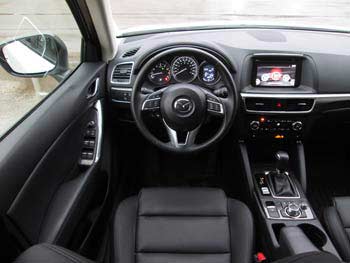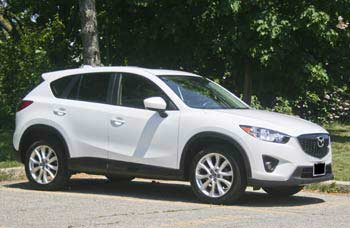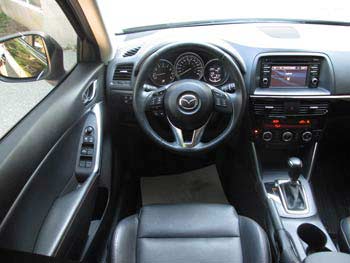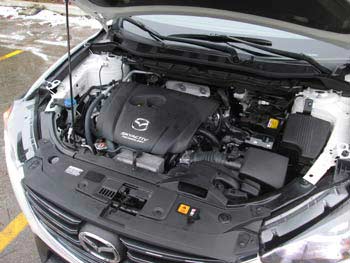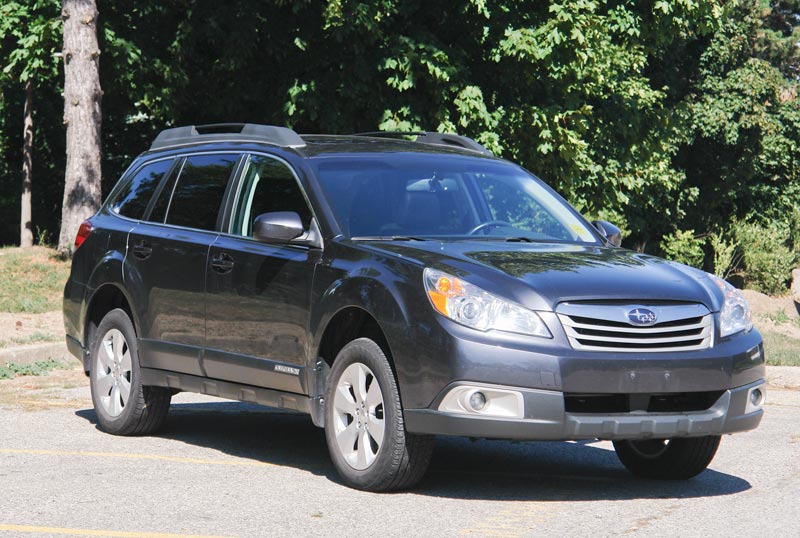Mazda CX-5 2013-2016: pros and cons, problems
By Vlad Samarin, Updated: May 08, 2023
The Mazda CX-5 is a practical 5-seater SUV. It offers a solid powertrain, great fuel economy and confident sporty handling. It comes with a 2.0L or 2.5L 4-cylinder engine and a proven six-speed automatic transmission in FWD or AWD variants. Both engines are very reliable. You can even get the CX-5 with a manual transmission (in FWD trims with a 2.0L engine).
The Mazda CX-5 is easy to maintain and can last over 200,000 miles with good care.
Pros:
- Reliable engines.
- Conventional 6-speed automatic transmission.
- Good on gas.
- Sporty, confident handling.
- Stylish looks.
- Simple automatic AWD system.
- Easy to maintain, easy to work on.
- The interior is not as roomy as in some other SUVs.
- Some road noise is noticeable.
- The driver's seat is not super comfortable.
- Fabric seat material could be better.
- The infotainment system is slow and glitchy.
The day running light LEDs are known to fail in the 2016 Mazda CX-5, but many vehicles with this problem were repaired under the recall.
A bad switch in the transmission shifter can cause the vehicle not to power off when the start button is pressed.
Overall, a used Mazda CX-5 is a practical choice; it's good on gas and won't cost a lot to keep it running. If the Mazda CX-5 that you want to buy came from the Salt Belt, have it carefully inspected by a knowledgeable mechanic. If the rust damage is excessive, avoid the car, as some of the problems will be expensive to repair.
Let's look into some of the common problems:
A faulty switch inside the transmission shifter assembly may cause the radio and other accessories to stay on (in ACC mode) when the car is turned off. The switch inside the shifter assembly must be replaced to resolve the issue. The part is not very expensive and is not very difficult to replace. We found several YouTube videos describing the problem and the repair.
Replacing one ignition coil is easy and the part is not very expensive; it can be purchased from a Mazda dealer. If spark plugs are old, it's a good idea to replace them at the same time.
A failed mass air flow sensor may cause the Check Engine light to come on. The car might also be difficult to start. The air flow sensor is also easy to replace. Read more about the mass air flow sensor.
According to the service bulletin 01-009/15 for the 2013-2016 Mazda CX-5, the code P013A: HO2S Slow response could be caused by a leaking exhaust gasket between the main and secondary catalytic converters, right before the rear O2 sensor. According to the bulletin, the gasket must be replaced if leaking. Other even minor exhaust leaks near the rear O2 sensor could also cause this code and must be repaired.
Advertisement
In regions where road salt is used in winter, corrosion at the rear brake calipers may cause them to stick and wear prematurely. There are several complaints on the NHTSA website. Electronic parking brake actuators can also be damaged by excessive corrosion.
Replacing one rear brake caliper will cost 1-1.8 hours of labor plus the part. For the electronic parking brakes, it's best to use OEM parts for repairs
We strongly recommend having the brakes inspected and serviced at least once a year to keep them safe.
The corrosion (especially in the Salt Belt) can also damage the A/C line from the condenser to the evaporator and the condenser itself causing the A/C not to work. Replacing the A/C line is not very expensive; but replacing the A/C condenser will cost more.
There are a number of complaints about the LED day running light not working or flickering in one of the headlights in the 2016 CX-5. The repair is expensive if out of warranty because the whole headlight unit must be replaced. Mazda issued Safety Recall 4320A - Daytime Running Lights (DRL) May Fail. Check with your Mazda dealer.
A bad wheel bearing can cause a humming noise that gets louder at higher speeds and when the vehicle changes direction. Replacing one wheel bearing could cost from 1.0 to 1.5 hours of labor plus the part.
Fuel Economy: The CX-5 is one of the most fuel-efficient SUVs. According to the EPA, the 2014-2016 2.5L all-wheel drive CX-5 gets 26 mpg combined (24/29 mpg city/hwy). With this gas mileage, the CX-5 can travel up to 428 miles (689 km) on one tank. The 6-speed manual front-wheel drive 2013-2016 CX-5 with the 2.0L engine is rated at 26 mpg city, 34 mpg highway. The CX-5 uses regular gasoline.
2013-2016 Mazda CX-5 Engines: The CX-5 offers two naturally aspirated (non-turbo) 4-cylinder direct-injected gasoline engines: the 155-hp 2.0L and the 184-hp 2.5L. Both engines are similar in design; Mazda calls them Skyactiv G. Both engines are proven to be reliable and easy to maintain. Read also: Pros and cons of buying a car with Direct Injection.
Timing belt or timing chain? Both the 2.0L and 2.5L Skyactiv G motors have a maintenance-free timing chain; there is no timing belt. The timing chain does not require regular replacements.
2016 redesign: For 2016, the CX-5 received an upgraded interior with better noise insulation and a different infotainment system. The 2013-2015 CX-5 has an audio system with regular buttons and an optional TomTom navigation. The 2016 CX-5 comes with Mazda Connect with the commander switch on the center console. The 2016.5 refresh added Electronic Parking Brake.
Mazda CX-5 Driving Experience: It's a lightweight sporty car-based SUV. It handles well in turns and emergency maneuvers, although the ride is firm. There is some road and wind noise, but overall it's a nice car to drive. With a 36.7-ft. turning circle, the CX-5 feels nimble in city driving and holds the road well on the highway. Compared to earlier models, the 2016 CX-5 feels a bit quieter inside.
2013-2016 Mazda CX-5: Is it a good car to buy? If you find one that is in good condition and not too rusted, then yes, the Mazda CX-5 is a good choice for a practical compact SUV. As of July 2022, Consumer Reports marks the 2013-2016 CX-5 as 'Recommended' and rates the overall reliability as 'above average'.
Another plus is that the lower portion of the vehicle is protected by plastic trim pieces. The 2.0L engine is very good on gas, but feels a bit underpowered. The 2.5L is a better choice. The 2015 CX-5 received the least amount of complaints. The 2014 and 2015 Mazda CX-5 also got better crash-test scores.
What to look for when buying a used Mazda CX-5: Check the service history records if they are available to make sure the oil changes have been done regularly. Test all the functions of the infotainment system; see if it is not lagging and all areas of the touchscreen respond to the touch. Check the rearview camera operation. In the 2016 CX-5, check if all the buttons work on the commander switch in the center console, as they are often sticking if some drink has been spilled on them.
Test the heater and the air conditioner, as well as the sunroof and other electrical accessories. During the test drive, watch out for abnormal noises. In the 2013 model, the hood could vibrate when driving on the highway. Read more: How to inspect a used car - illustrated guide. Watch out for signs of transmission issues, such as delayed engagement, slipping or slamming into gear after coasting. Read more: Signs of automatic transmission problems when test driving a used car.
In the 2016-plus CX-5, check if the LED strips within the headlights (DRL) are working and not flickering. Watch out for the warning lights staying on after the engine is started.
Before purchasing, have the vehicle carefully inspected by an independent mechanic, especially if the car is from the Salt Belt. If excessive rust is found during an inspection, avoid the vehicle. Some of the problems caused by excessive rust will be expensive to repair.
How capable is the AWD system? The CX-5 has a simple automatic all-wheel drive system. Front wheels are powered at all times. When needed, some amount of torque is sent to the rear wheels; the electro-magnetic clutch that engages the rear axle is located in the front portion of the rear differential.
Although it's not a system for serious off-roading, it gets the job done when needed and is reliable for the most part. In terms of maintenance, the AWD transfer case fluid and the rear differential fluid must be changed regularly (every 60-80K miles). Both services are not very expensive. The drive (propeller) shaft and the rear axles must also be regularly inspected.
Related reviews:
Toyota RAV4 2006-2012
Honda CR-V 2007-2011
Honda CR-V 2012-2016
Volkswagen Tiguan 2009-2017
Jeep Cherokee 2014-2020
Nissan Rogue 2014-2020
Chevrolet Equinox 2010-2017
Mazda CX-5 Maintenance Tips: Mazda doesn't mention the automatic transmission fluid change in the maintenance schedule, but the fluid deteriorates and gets dirty over time. If you want to change transmission fluid, we recommend getting it done at a Mazda dealer, as the transmission uses special Mazda fluid. It's a good idea to change the rear differential and transfer case fluids at least every 60-80K miles.
Brakes need to be serviced at least once a year. We recommend using good quality synthetic oil for the engine and have it changed regularly, at least every 5,000 miles. Spark plugs must be replaced every 75,000 miles, or 120,000 km, according to the 2016 CX-5 owner's manual. We noticed that chips in the paint can get corroded if not touched up in time. You can buy a touch-up paint pen at your Mazda dealer.
Resources:
Safercar.gov - Check for recalls
Mazda Connect - how it works, FAQ, How-to guides.
